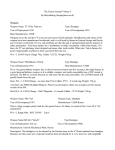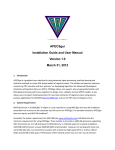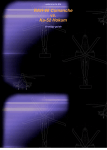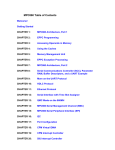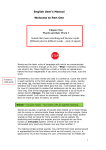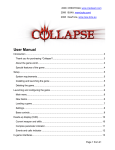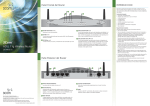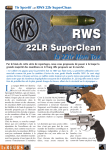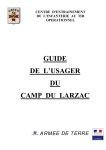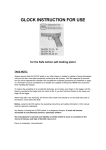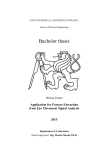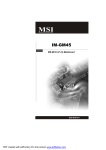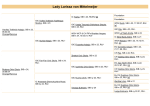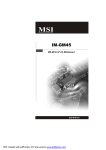Download The Fuzion Arsenal V. 3
Transcript
The Fuzion Arsenal V. 3 By MicroBalrog ([email protected]) Disclaimer: This volume contains not only all the weapons from previous versions, but a whole bunch of different weapons as well. I have received e-mails critical of my site because it “promotes guns”. To the authors of those emails I dedicate the following picture of what seems to be an FN P90. It’ll do them (and you) a lot of good to follow the hyperlink. How to read the ROF notation? You will note that a weapon will have an ROF notation looking like 3/3/10/30. That will be deciphered like this: the first number is the amount of shots that a character can fire PER ACTION. (If he has more than 1 action, he can fire that amount of rounds per each action.). He suffers a –1, cumulative, to each shot after the first. The second number is for those guns which have a fixed-burst setting, and stand for the amount of rounds per burst. The amount of bursts is equal to the amount of round s that can be fired on the semi setting. That is done on a penalty of –2 to the second burst and –3 on the third. So if you had the gun on the example above (3/3/10/30), you could fire up to 3 bursts per action out of it. But if you switched it to the full-auto setting, you could fire it in 3 1-second burst of 10-rounds (you could add or substract 1d6 shots from each burst for randomness’ sake, with the same penalty as for short bursts.) or a long 30-round burst (The last number is also an upper limit to ho w many rounds you could pump out of a full-auto weapon per phase, no matter how fast you are. Firing on full-auto gives you a +1 on each 10 rounds (round fractions up or down) after the first ten. Firing the gun in our example in a long burst would give y ou a bonus of +2. Firing a YakBU-12,7 (a Russian minigun with a ROF of 0/0/83/250) the same way would give you +24 bonus, but don’t forget miniguns would be used in different situations. Consider this: Little Timmy is shooting a Black Cabal operative in a small room at 3 meters with a full burst from an AK-74. He has no range penalty, a +1 modifier from using the AK-74 and a +2 from being on full-auto. For simplicity’s sake, let’s assume Timmy has a basic AV of 12 and the operative has a DV of 11. The GM decides to use a d20 for the roll. Little Timmy rolles 12+2+1+D20, and gets a 28, while the operative rolls 11+D20 and gets 15. Using a Simplistic system (divide amount of rounds by the Autofire ratio, which is, say, 2), we determine that the operative gets shot 15 times. Now Little Timmy is on a helicopter, shooting at the Black Cabal Operative from a height of 300 meters with a 250 round-bursts from a YaKBU. He has a +24 for all those rounds, and –4 range penalty. Because the Operative is hiding beneath a thick forest, he has a –2 cover penalty, and –1 because the Operative is moving quickly. He also has a –20 penalty, because the helicopter is moving at 240 kph. So he rolls 12 –3 + 1D20 to get 18 and the operative gets to roll 11 +1d20 to the resulting critical success of 31. Then he gets to shoot back with his Strela-3 missile system. Weapons Handguns Name: Smith & Wesson Model 500 Date of Manufacture: 2003 The new Smith & Wesson Model 500 revolver is the most powerful revolver in the world. The new 500 S&W Magnum® cartridge is the most powerful production revolver cartridge ever developed. The new Model 500 revolver is packed end-to-end with original, neverbefore-seen Smith & Wesson features. The 500 S&W Magnum® cartridge can deliver more than a ton and a quarter of muzzle energy, so the Model 500 is built on the massive new Smith & Wesson X-Frame. The strongest S&W revolver ever built weighs in at 72.5 ounces with an 8 3/8 -inch barrel and a rugged five-shot cylinder. It’s big. Big as it is, the Model 500 is well-balanced and comfortable to handle; and it is remarkably manageable thanks to its recoil compensator and brand-new Hogue design Sorbathane® wraparound rubber grip. The Model 500 also utilizes a strong new ball-detent frame-to-yoke cylinder lock, a solid ejector rod, and a new two-piece barrel and barrel-shroud design for maximum strength. With Smith & Wesson’s classic Micrometer-click adjustable rear sight, interchangeable front sight blades, drilled and tapped frame for easy optics installation and traditional Smith & Wesson accuracy built-in, the Model 500 is ready for any big-game animal walking. With the new Model 500, Smith & Wesson has once again taken the Magnum Handgun concept to an unprecedented level. (From www.smith-wesson.com ) Name: Smith & Wesson Model 329PD Date of Manufacture: 2003 Weighing under 27 ounces, the Model 329PD offers big bore Magnum® performance in an easy to carry, lightweight revolver. The scandium frame, titanium cylinder, 4-inch barrel revolver is chambered in .44 Magnum® . The matte black finish offers low light reflection and ease of maintenance while the HIVIZ® front sight makes sight acquisition quick and positive. Each Model 329PD co mes with both an Ahrends finger groove wood grip and a Hogue rubber monogrip. (Graphic and text from www.smith-wesson.com ) Name: Smith & Wesson SW1911 Date of Manufacture: 2003 John Browning’s design for the original Model 1911 .45 ACP autoloader is more than a century old, but it remains one of the most popular pistols in the world. Now Smith & Wesson offers the new .45 ACP Model SW1911?a true Model 1911 with all the traditional specifications and performance of the classic original, plus enhancements. Every modern feature you would expect on a fully-equipped current Model 1911 pistol is already built into the SW1911 from its pinned-in external extractor to the patented S&W firing pin safety release that is activated by the grip safety instead of the trigger. Plus, the SW1911 is fully-accessorized with well-known premium brandname Model 1911 accessories including Wolff springs throughout, a Texas Armament match trigger, Chip McCormick hammer and thumb s afety, a Briley barrel pushing, two Wilson 8-round magazines, a full-length heavy guide rod, a high-profile Wilson beavertail safety, and Novak Lo-Mount Carry sights, to name a few. And all of this is put together with a slide-to-frame fit that rivals anything you’ll get from the best custom pistol-smiths, delivering match-grade accuracy. For straight-from-the-box competition, for duty or personal defense - the new Smith & Wesson Model SW1911 is ready for any challenge. (From www.smith-wesson.com ) Kimber Pro-Carry II Date of Manufacture: 1996 Kimber has made a host of various 1911 variations, adapted for various uses. All of them are reliable and accurate, just like a Kimber should be. The Kimber Pro -Carry is a variation introduced due to socalled “CCW Reform” (the passing of laws which make it easier to get a license to carry concealed weapons) which occurred in many states, and is, obviously, a 1911 modified to be more comfortable to carry secretly. The Kimber Pro-Carry is light, compact, accurate, safe (all models have advanced safety setting, and, for all centerfire Kimbers made starting from February 2003, a loaded chamber indicator) and, what is maybe the most important thing for a weapon of selfdefense, reliable. Also see http://www.kimber.com Name:H&K P2000 Manufacturer: H&K, Germany Developed by Heckler & Koch especially for use by police, this weapons flashes several various complicated safety systems which ensure that the gun will not be accidentally fired but which are easily disabled when needed. The gun is small, compact, and easily concealable. Name: MP412 Manufacturer: IzhMekh, Russia This new weapon has several outstanding features. First, it has a nostalgic, break-open reloading method, not unlike the Smith & Wesson guns of the end of the XIX - start of the XX century. Second, the upper part of the gun is build of metal, while the lower part (the grip) is made of polymer plastics. Weapon Name: TT (Tula Tokarev) Year of Development:1930 Year of Deployment:1930 Main Manufacturer: USSR Old guns never die, and the TT is just one more proof of this prinicple. Modifications and clones of the weapon have been manufactured worldwide, and it is still used by hitmen in Eastern Europe and Russia and terrorists world wide. It's two only problems are that the grip is unergonomical and the absence of safety mechanism - it has been replace by a "preliminary cocking" mechanism, which often breaks. If it does, the TT can discharge when dropped and cause other such trouble. Otherwise, Tula is famous for good weaponsmiths, and they've done a good job this time too. Weapon Name:PM(Makarov Pistol) Main Manufacturer: USSR Year of Deployment:1950 Not a very good military weapon, due to the low-powered ammo and low accuracy, but might feature as a good personal defense weapon, as it is reliable, compact, and easily concealable (use of JSP rounds is advised). The PM (or versions thereof) are still used with the army and militia. Use of PMM rounds will quickly wear out the gun. A bit later, the PMM (Modified Makarov Pistol) was developed, which was an improved version of the PM, built to shoot PMM rounds. Weapon Name: PSS 'Vul' Manufacturer: USSR/Russia Year of Development:1981 This is a higly compact pistol, built for the special forces. No flame, no sound of fire. Uses SP-4 7.62 ammunition. Weapon Name:MP-443 "Grach" Year of Deployment:Not yet Year of Development:1990s Manufacturer: Izhevsk Mechanical Plant, Russia Description:This handgun is to be adopted by the Russian army as the 9*19mm standard issue handgun. Rumours are that some sort of special round has been developed for it. It is, however, still compatible with 9*19 mm Parabellum rounds. There is nothing special about the pistol, except that the extractor (whatever that is) is also used to indicate presence/absence of a round in the chamber. MP-451 'Derringer' Year of Development: 1990s Manufacturer:Izhevsk Mechanical Plant, Russia This small, extremely compact pistol has been developed for private use and selfdefense. Although this pistol is double-barelled and has only two rounds in it (it' loaded like a miniature double-barreled shotgun), its superiority is in its extremely smalll size - the Derringer can be hid practically anywhere on your body. Name:MP-444 'Bagira' Year of Development: 1990s Manufacturer:Izhevsk Mechanical Plant, Russia 'Bagira' is a new technological concept of the Izhevsk Plant. The people who brought to you the Kalashnikov are now coming out with a rigid-plastic pistol, just fit for the high-tech age. Versions of the weapon are available for 9*17, 9*18, and 9*19 rounds. Weapon Name:Gurza/Vektor SP-1 Year of Development:1996 Year of Deployment:1996 Manufacturer: Russia This weapon was ordered by the army, but as it lost interest, it was adopted by some special services. This extremely powerful handgun fires its own unique 9*21mm armour-piercing ammunition (9*21mm SP-1, SP-10, SP-11), good enough to punch a hole through 30 layers of Kevlar and 2.8mm of titanium at 100 meters, and designed to penetrate kevlar jackets of II-III protection levels. Weapon Name:APS (Stechkin Automatic Pistol) Year of Deployment:1950's Year of Development:1950's Manufacturer: USSR This was originally adopted for use with the special forces. It is compact, and with an ROF of 600 rpm, can be a very cool weapon. Its standard holster is rigid and can be fitted to use as a buttstock, and this is the way it should be fired when on full-auto. If not using the buttstock you have WA -1 when firing full-auto. In the 1980-s a modification of APS, known as APSB (silenced APS) was adopted to use with external silencer and a special buttstock (not a heavy wooden holster, but a metal buttstock much like one used with many modern SMG's). Today it is very difficult to find an older APS with holster/butt-stock (it is heavy and hard to conceal). There’s 5 APS pistols currently in legal civilian ownership in the U.S.A. This number is set because of the machinegun clause of FOPA-1986 (which stated you could only own those machineguns legally registered before May 19th, 1986). Submachineguns Weapon Name: Kedr (Cedar) Manufacturer: Russia This submachinegun has been designed to be used by special operations forces and tankers. Weapon Name:Vikhr(Whirlwind) Year of Development:1990s Year of Deployment:1990s Manufacturer: Russia Description:This is a weird weapon, a crossbreed between a rifle and an SMG, one of the first weapons in the new 9*39 caliber. As all the 9*39's, this is mainly a special ops weapon. Name: Thompson SMG aka Tommy-Gun Start of Production: 1920 Developed: 1919 This world-famous submachinegun was developed by Captain John Thompson and was to become one of the most popular SMG's of all times. Used by the British and U.S. militaries and police, Chicago gangsters and Tel-Aviv Zionists, it is an emblem of the first half of the 20th century. Even now, Auto-Ordnance is still producing a civilian (semi-auto only) Thompson. Why did they have to introduce that stupid law in 1934... Name: MP-38/MP-40 aka Schmeisser Deployed:1940 Developed: 1938/40 The MP-38 was developed by the engineer Folmer in 1938. (The name Schmeisser is merely a nickname, not an official name). It quickly entered service with the Wehrmacht. It was first designed only for commandos and AFV crews, but then was quickly adopted with the infantry Wehrmacht and SS. The MP-40, designed two years later contained no major construction differences. Although the gun is very stable an easily controlled, it has one major drawback - the barrel is uncovered, meaning that after firing lots of rounds, it becomes hot, and although it's not known to overheat, it can cause burns on unprotected hands. Weapon Name: H&K Model 54 a.k.a. MP5 This is perhaps one of the most famous submachineguns in the world, only rivalled by the Uzi and the Scorpion. First deployed with the Bundeswehr in 1961, this weapon, accurate like German clockwork, has spread itself to the use of armies and special ops forces all over the world. Various versions have been created, as listed below. Unless specified otherwise, the weapon caliber is 9mm Parabellum. 'MP5 A2 - HK-54 as described above with S-E-F trigger pack and fixed full length stock. [Trigger switched from safe to semi, to full auto, no burst-fire - MicroBalrog] MP5 A3 - HK-54 as described above with S-E-F trigger pack and retractable stock. MP5 A5E - HK-54 as described above with new style 4 position trigger pack allowing safe, single shot, counted burst, and full auto operation. (Short burst available, that is) MP5 SD1 -HK-54, with integral sound suppressor, as described above with S -E-F trigger pack and receiver end cap (without butt stock). MP5 SD2 - HK-54, with integral sound suppressor, as described above with S -E-F trigger pack and fixed full length stock. MP5 SD3 - HK-54, with integral sound suppressor, as described above with S -E-F trigger pack and retractable stock. MP5 SD4 -HK-54, with integral sound suppressor, as described above with counted round burst trigger pack and receiver end cap (without butt stock). [all autofire modes available - MicroBalrog] MP5 SD5 HK-54, with integral sound suppressor, as described above with counted round burst trigger pack and fixed full length stock. MP5 SD6 HK-54, with integral sound suppressor, as described above with counted round burst trigger pack and retractable stock. MP5/10 HK-54 as described above chambered in 10mm Auto. This version of the submachine gun was designed for sale to U.S. "law enforcement agencies". This version of the submachine gun is identical to the standard 9x19mm version except for the chamber specification and a different magazine. MP5/40 HK-54 as described above chambered in .40 S&W. After U.S "law enforcement agencies" determined that they had screwed up with the 10mm Auto cartridge, they decided that the .40 S&W would be better. So, this version of the submachine gun was also designed for sale to U.S. "law enforcement agencies". This version of the submachine gun is identical to the standard 9x19mm version except for the chamber specification and a different magazine. MP5/Navy The United States Navy has adopted a modified version of the MP-5. This firearm is essentially the same firearm as used by the FBI and other supposed law enforcment agencies.' From: Gil's Firearms Page Name: Uzi Year of Developement: 1949 Manufacturer: Israel Military Industries, Fabrique National (Belgium) This world-famous submachinegun was developed by an IDF lieutenant known as Uziel Gal (hence the name). It has since been manufactured by the million, and deployed with armies all over the world including Germany and Belgiun. The Uzi is a perfect weapon for urban warfare, but breaks down easily in conditions where dirt or sand abounds. The UZI has two safety arranngements - one, the fire-rate dial, which can be set on no-fire, single shot, and Scoped Mini-Uzi being used at Knob C reek extended fire (like in the MP5). Thus, setting the safety and setting the fire rate can be done in 1 action. The second safety arrangement is a button on the handle, which is pressed when the user grasps the gun firmly. If it is not pressed, the weapon cannot be fired. An Uzi has two mountings for tactical flashlights, optical sights and other similar accessories, one under, one above the barrel. The full-sized Uzi also can be mounted (and sometimes comes) with a knife-bayonet. However, the production of the full-sized version has recently stopped. Shotguns Name: Saiga 12K Manufacturer: Russia Development: 1990s A semiauto 12-gauge shotgun based on the AK-74. ‘Nuff said Name: HK - Benelli XM1014 Combat Shotgun System Manufacturer: H&K-Benelli Developed:1999 Deployed: Assumed 2000 Designated the XM1014 Joint Services Combat Shotgun (JSCS), the weapon was invented by Benelli for H&K, for use by the US Marine corps. A total of up to 20,000 guns were ordered, but more might be produced for other services. It is semi-auto, accepting manual feed of bormal and 'less-than-lethal' ammunition. Three kinds of buttstocks are available: the default telescoping stock with a detachable pistol grip or the optional semi-pistol grip or pistol grip stocks, each of which can be installed without tools (!!!). Name: USAS-12/Street-Sweeper This is the one we've all heard of. The epitome of the shotgun. It's cyclical ROF is enough to empty it's magazine in 3 seconds, it's 12 gauge, and it's drum fed 12 shells! It's low-recoil qualities allow you to reduce recoil penalties by -1 or fire the weapon hand-held. In the mid-90’s ATF reclassified the weapon as a “destructive device, making it about as legal to buy as a machinegun. Rifles Name:Knight's Armament SR-25 Manufacturer: Knight's Armament, USA Deployed:May 2000 This sniper rifle comes from Eugene Stoner, author of the M16, AR-15, M4, and many other assault rifles. It is rumoured to be an extremely good weapon. It comes in the following modifications: Match rifle, with 24" (609mm) barrel, Lightweight match rifle with 20" (508mm) barrel, carbine with 16" (406mm) barrel, and Sporter, with 20" (508mm) not freefloated barrel. The barrel being free-floating means you reduce you recoil penalty by 1. The weapon (the Match rifle, most probably) has been deployed with the U.S. Navy SEALS. Almost all of the parts but the receiver, the hammer, the barrel assembly and the carrier/bolt are interchangeable with the M16 and family. Name: DSR-1 Manufacturer: Germany, AMP Technical Services You can never be too good. The AMP Technical Services DSR-1 goes out to prove it. This is, perhaps the best sniper rifle in the world. When using sniper bullets, and in good weather (no wind), it can make 5 rounds go in almost the same (5mm distance between hit spots) spot in the target, creating a only a small (about 11 mm wide) hole in the target. These results, obviously, Would be impossible to duplicate in the field. The rifle is indeed incredibly good. Adopted by the GSG-9 and other services in Europe. The weapon is manufactured in 3 different calibers:7.62mm NATO (.308Win), .300 Win Mag, .338 Lapua Mag Name:B-94 Manufacturer: Russia This is a new Russian sniper rifle. Quite simply, it’s the 12.7*109 counterpart to the Barrett. Comes with a built-in optical scope and a bipod. Name: Tigr/Tigr-1 (Tiger/Tiger-1) Developed: 1990s Manufacturer: Russia The Tigr series of hunting rifles was created based on the SVD. It's extremely reliable, works under any temperature from -50 to +50 Celsius. Built to hunt medium to large animals, the rifle is as suitable to hunt the most dangerous prey of them all. Can be ordered with a special optical sight that can mount itself on the gun (t he mount is part of the sight, not of the Tigr). Name: Heckler&Koch G3 Deployed: 1957 This was the standard issue weapon of the Bundeswehr up until the war in Yugoslavia, when the German army had to start moving over to the H&K G-36, which is a 5.56 NATO weapon, compatible with the weapons of other NATO forces. Currently (as of 2002) the G-3 is not yet totally replaced by the G-36 in the Bundeswehr. Over 20 countries except Germany employ the G-3. A well-known variant of the G-3 is the HK3KA4 - a version with a shortened barrel an a telescopic buttstock. Name: Daewoo K-2 Manufacturer: Daewoo (South Corea) The K-2 rifle family was developed by Daewoo to replace the old M16A1. It fuses elements of design from both the M-16 and the AK to achieve what is to be the new mainstay weapon of the Korean army. The Following models exist: K-2 - 5.56, collapsible plastic buttstock K-1 - 5.56, telescopic metal buttstock, shorter barrel DR-200 - civilian model, non-collapsible plastic buttstock, semi-auto only DR-300 - civilian model, non-collapsible plastic buttstock, semi-auto only, 7.62*39 Name: Galil(Galilee)Manufacturer:Israel Military Industries This an attempt to rechamber the AK-47 for the 5.56. A poor rifle, the Galil has several features to distinguish it from the basic AK - a collapsible buttstock, a longer barrel and a shifted set of sights, which does not allow for Galil SAR in special ops edition accurate aim. A shorter version, named Galil SAR(or,in slang, 'Glilon') is issued mainly to officers, special force troops, and tankers. An LMG and a 7.62 sniper rifle also exist. The different versions are known as the Galil ARM (LMG), Galil AR (Assault Rifle), Galil SAR (Glilon– shortened rifle), and Galil Sniper. However, there’s no practical difference between the Galil ARM and Galil AR. Name: Galil-Tavor Manufacturer: Israel Deployment: Recent This is the newest deployment with the Israeli Defense Force. The Tavor is supposed to phase out both the Galil and M16 assault rifles currently in service. The designis a bullpup with integral optical scope, with a bluish hi-tech look. The stats below are for the standard assault rifle. Sniper, compact, and Micro-Galil versions will also be available. The M203 launcher and other NATO-compatible accessories can be mounted on the Galil-Tavor. Name: C7 Canada Deployed:1984 Manufacturer:Diemaco, This is a Canadian version of the M16A2, modified to have full-auto fire capabilty instead of the M16A2's burst-fire. Comes in the following versions: C7 - simple re-make of the M16A2 C7A1/C7FT - C7 Flat-Top rifle, comes with a mounted 3.4 scope. C8 - A remake of the M4. Used by Canadian gendarmerie Other modifications are also available to foreign customers. The C7 and rifles can be mounted with Diemaco's own version of the M203. It comes with it's own black plastic magazine, but can be fitted with those of the M16 as well. Stats are not provided for this weapon, as Mark Chase already did an excellent job with M16 stats. I’ll bother when the Canadians make something original. Weapon Name: SVD(Dragunov Sniper Rifle) Manufacturer: USSR/Russia The SVD isn't exactly a sniper rifle. It's main purposes is to provide infantry with exacting fire support in the field (e.g. suppressing enemy firepower, machinegunners etc.) in the 600 meter range (although the user manual lists the range as 1000m, so use what you like best). The ammo is 7.62*54, although there is a steel-core sniper bullet available in the same caliber (+1 WA +1 DC AP ALL). Rifle is available in folding-stock version. It comes prepackaged with: 1)A knife-bayonet, compatible with the one coming with assault rifles. 2)A PSO-1 *4 magnification sight 3)A carrier for the sight and magazines (fits 4 clips) 4)A sling for carrying small arms (fits for 2 weapons). 5)A small bag, designated .for SPTA (whatever that is). AK-47 rifle series (AK stands for 'Avtomat Kalashnikova', or Kalashnikov Assault Rifle) Developed:1947 Deployed:1951 Versions Available: AK-47 (Wooden Buttstock) AKS-47 (Collapsible Buttstock) This is Kalashnikov, the most popular rifle series on the planet. It's in fact so popular, that in some places the word Kalash became a popular boy's name. Variants of this rifle or the AKM are still produced in various countries, and there are about 90 million Kalashnikov rifles in the world currently (vs. about 10 million M-16 rifles - the second most popular ones. You might also note the availability of a 100-round curved mag for the AK guns. Happy happy joy joy... In 1959 the Soviets modified and improved the AK-47, creating the AKM. The AKM looks practically identical to the AK-47 and is almost as common (and is often confused with it, so you might probably expect a fixer to occasionally sell you the wrong gun). However, it is NOT the same. It has better ergonomics, safety, and lower weight. The fire mode switch is positioned near the trigger (as in all subsequent AK rifles, allowing the switching of modes as a free Action). A frequently used modification is the AKMS - a folding stock version of the AKM. Final note: although the AK rifles (both AK-47 and AKM) heat up after firing a lot of bullets, they almost never blow up during fire. AFAIK, this has never happened yet. Again, AK's are super-reliable. Reliability is the AK's motto. RPK (Kalashnikov Light Machinegun) Developed: 1961 Main Manufacturer: USSR Deployed: 1964 This is a light machinegun version of AKM. This gun can be fed from 75 or 45 round boxes or the RPK 100-round box (compatible with AK), or any AK magazine. Because of the design of this gun, care should be taken not to overheat it, which will cause deformation of the barrel, and incorrigible destruction of the weapon. The weapon also needs to be cleaned often, as dirt and residue from the fire tend to accumulate in the mechanism and to gradually slow down the rate of fire. These problems are not found in any other AK guns. Also available as the RPKS in foldingstock version. Vepr’(“Wild Hog”) is the RPK made into a hunting rifle. AK-74 rifle series Development: 197 Modifications: AK-74 (Kalashnikov Assault Rifle), deployed in 1974 AKS-74 (Kalashnikov Collapsible Assault Rifle), deployed with paratroopers in 1977, later with other units. Main Manufacturer: USSR This is nothing less than an AK-47 redesigned for modern assault rifle ammunition. The only problem with this gun is the ammo. The old Russian-made 5.45 ammo (designated 5H7) was an unstable, weak round (-1 DC, -1 WA when using it, no AP capability). The new 5H10 ammo is fully functional. Note, though, that Nobel Industries also Russian ladies with AK-74’s make 5.45 ammo, and it is (along with semi-auto ‘74’s) available in the U.S. The official armour-piercing round (codename 5H22) is 7DC AP (Half-damage vs. flesh). Name: AKS-74U Manufacturer: USSR Developed/Deployed: 1979 Submachinegun? Yes. Pistol caliber? Suck my barrel. This baby fires 5.45 by 39 rifle ammunition. It comes with a built-in conical flash suppressor. The recoil is reduced by various means, creating a powerful, accurate gun with a screaming ROF of 650 to 735 RPM. All Soviet rifle add-ons, grenade-launchers included can be added to it. Of note is the fact that it’s Bin-Laden’s favourite gun – in all his videos, he is seen with an AKS-74U which he claims used to belong to a Soviet general he killed. RPK-74 (Kalashnikov Light Machinegun) Manufacturer: USSR Deployed: late 1970s This is the LMG version of the AK-74. The gun fires standard AK-74 ammunition from 45- and 40-round boxes, also often using the AK-74's 30-round mag. Comes with a built-in flash suppressor. Unlike with the RPK, no civilian versions were ever developed. Name: AN-94 'Abakan' (Nikonov Assault Rifle, Abakan is a name of a place) Manufacturer: Russia You thought H&K were best? Think again. This baby has three fire modes:semi-auto, short (two-round) burst, and full auto. On burst, it fires on 1800 rpm, and the firingmechanism works in such a way that the gunman only feels the recoil AFTER the bullets leave the barrel. For game purposes, this means both bullets hit the same location. On full auto, the first two rounds are fired at 1800 rpm and hit the same location, and the gun then shifts to 600 rpm. And the best part is: the gun got developed in the mid-1990s for an Army competition, was accepted as the official infantry weapon but not has not yet been deployed. Be afraid. Be very afraid. PK (Kalashnikov Machinegun)(Aka PKS) Manufacturer: USSR This is the basic Kalashnikov machinegun, from which all the PK machineguns (PKM, PKT, PKB etc.) are derived. It receives its 7.62*54 ammo via belt feed from a 100-round box at the side of the gun. (Other PK's afford larger ammo boxes). It can be fired hand held at WA -2, but you risk tripping over the non-disintegrating ammo chain. Note: For mounting on vehicles, you might use the PKT, which is basically the same, except the trigger was replaced by and electrical firing-mechanism (also there is an emergency manual trigger). PKM (Modified Kalashnikov Machinegun) Manufacturer: USSR The PKM is an improved, lighter version (8.4 kilograms) of the PK, using stamped metal components instead of machined metal. Joinable 25-round sections of nondisintergrating metalic belts feed the bipod-mounted PKM. An assault magazine attached to the rails under the reciever can cary 100 cartridges belted in this way. Either 200- or 250-round belt boxes can also feed the PKM. Can be fired hand-held at -2 to WA KPV heavy machinegun Main Manufacturer: USSR, China Ah... finally we come to a Russian baby that isn't Kalashnikov. This is a real baby, I assure you. Its' 2 meters long, it's almost 50 kg, but - it's 14.5 millimeters! Heavy, big, nasty! Although Russians stopped production long ago, Chinese, Iraqis, and some othere still have it deployed with their armies. And, the only ammo available is Armor-Piercing Incendiary, AP Incendiary Tracer, and Incendiary tracer! Final Note: The bastard GM might note the availability of double (common), triple and quadruple mountings (not so common). Throw these at your players. Name:NSV Manufacturer:USSR/Ukraine Deployed: Middle 1970s This machinegun was adopted to replace the outdated DShKM. It comes with a variable *3-*6 sight. Due to some construction weirdness, it can't be used for AA fire from the standard 6T7 tripod. A special tripod, the 6U6, was developed for this purpose. The NSVT version is still used on many modern Russian tanks (and obviously on Ukrainian ones too). Name:Kord Year of Development:1991 Year of Deployment:1990s Manufacturer: Russia This weapon was developed at the Dragunov Plant so as to replace the Soviet NSV machinegun (as the NSV plants were in Ukraine) and to increase accuracy of fire.The barrel is aircooled, and can be quickly changed if overheating occurs. The machinegun can be fitted with optical or night scopes. The infantry version comes with a 6T7 tripod. Name: PTRD (Protivotankovoe Ruzhye Degtiarieva, Degtyarev AntiTank Shotgun) Manufacturer: USSR Some shotguns are for ducks, some are for bears. This one is for tanks. It is used just as any normal anti-tank rifle. Its 14.5*114 (yes, exactly, you are reading it right, it's not a typo) round is 14DC (1 Kill AP all). Comes with a built in bipod. Cases are known of the PTRD being used as a sniper or AA weapon. The only problem with the PTRD is that it's extremely long (2000mm, that's 2 meters), which makes transportation quite a problem. .416 Rigby Springfield There’s a whole lot of people out there who like to hunt big animals. Real big ones, I mean. African leopards, and rhinos, and grizzlies, and all of that stuff. Of course, to hunt really big animals you need a BFG (Big Fine Gun). The .416 Springfield is exactly that – a Springfield .30 bolt-action rifle redesigned to carry the .416 cartridge. It is the same rifle that Raymond Drake-Tealy uses in “Pallas”. Grenade/Rocket/Missile Launchers Name: GP-30 Deployed:1989 Developed:1987 Manufacturer:Russia This weapon, compatible with all the AK guns and probably the Abakan, is a much more compact and accurate brother of the M203, and can be mounted on the gun without almost any previous weaponsmith skills. Can be used for indirect fire. Uses the soviet GP-25 40-mm grenades (same as US 40mm grenades for damage purposes). Weapon Name:Shmel(Bumblebee) Year of Development:1980's Year of Deployment:late 1980s Manufacturer: USSR/Russia The Russian way to bring back the flamethrower. Practically, this is a shoulder-fired grenade launcher. Three modifications exist: RPO-Z - Incendiary, RPO-D - Smoke, and RPO-A - Thermobaric. Now this is a fine weapon! Providing a powerful explosion, combined with the heat blast of a thermite bomb and the accuracy of an RPG, this, perhaps, is the urban weapon of tomorrow, as (and sometimes more) efficient than a 155 howitzer. Weapon Name: Strela 2 (Arrow 2) aka "Grail" SA-7 (NATO designation) system aka 'Grail' SA-N-5 (NATO designation of Navy version) Period of Development: 1959-1966 Deployment:1966 Manufacturer: USSR This is the precursor of the Stinger missile, first used by the Arabs in 1973. Israeli airplanes dropped like flies, making a staggering loss of 134 aircraft in the first few days of the war. This success was largely due to the high quality of the Soviet-made AA defense systems, including Strela 1 (and probably 2). Strela launchers are often used by terrorists (as are Stingers). Last one was a use of a Strela-3 to down a Russian army transport helicopter in 2001, kiling two High Command generals. Strela-2 can attack anything on altitudes of 18-4500 km How do you use the Strela weapons simple: "When the operator acquires the target, he activates the thermal battery amd when the seeker has acquired the target he receives an audio signal. He then partially pulls the trigger and activates the missile gyros which are warmed up in four to six seconds[2 phases]. The operator then uses stadia reference marks to compute the lead angle to the target then fully engages the trigger to launch the missile". Notes: An improved version, called the Strela 2M (SA-7B 'Grail' Mod), is avaliable. Weapon Name: Strela 3(Arrow 3) aka 'Gremlin' SA-14 (NATO designation) system aka 'Gremlin' SA-N-8 (Navy version) Year of development: Unknown Deployment: 1981 Manufacturer: USSR/Russia This is new, improved version of the Strela. It is probably similar to Strela 2, but features a cryogenically cooled seeker, possibly to provide a full frontal target engagement capability (whatever that means). The missile may also feature infa-red signal processing to make it less vulnerable to countermeasures (harder to be diverted from target, that is). Can hit targets at 10-5500 meters height. Name: RG-6 (Hand-held Grenade Launcher) Developed: 1993, currently deployed Manufacturer: Russia This baby is simply a big, hulking revolver. It fires Russian 40mm grenades (incomplatible with the NATO ones). Has a safety setting (as Russian grenades have no timers) and a folding stock. More or less a rifle-size weapon, but better than a rifle. Name: TKB-0249 'Arbalet'(Crossbow) Manufacturer: Russia Developed: Around 1998 This isn't a sniper rifle. It isn't a grenade launcher. It's a sniper grenade launcher. A low-weight, low-recoil weapon, the 'Crossbow', designed by Valery Nikolyaevich Teleshov, it is the ultimate sniper weapon. The grenades are the standard 30mm grenades from the AGS-30. The gun is equipped with an optical sight. The gun is fed from a 5- or 10-round drum. IMPORTANT: the grenades don't fly further than 1700 m. Name: AGS-30 Manufacturer: Russia You thought the MK-19 was tough - check out this baby and think again. This light weight baby fires the 30mm grenades of the AGS-17, ensuring 90% lethality in 8 meters radius of hit, is easily man-portable and is quickly set up to fire from unprepared locations (i.e. from anywhere.) Normally, two men are the crew, one carries the AGS-30, and the other - the ammo -normally 90 rounds in belts, which are usually in 30-round boxes weighting 13,7 kg each. It can be used for indirect fire. It also comes with an *2,7 sight. Name: RPG-27 'Tavolga' Despite the fact modern Russian RPG's are extremely powerful, most of them can't do well against ERA. Therefore, in 1983 an order was issued for a tandem-warhead disposable LAW. The answer was the Tavolga. Powerful, exact, able to defeat ERA of almost all kinds, the weapon was accepted into the Soviet arsenal in 1989 as a supplement to the RPG-26. Name: RPG-29 'Vampir' (LAW-29 'Vampire') Manufacturer: USSR/Russia Development & deployment: End of the 80s In disassembled state, it looks like two short tubes, and is easily carries in a backpack. Normally, 2 people carry the RPG-29 (One takes the gun, the other -the round) on the battle-field. The weapon is the easily assembled into a longish (about 2 meter long) tube with a built-in tripod. It has to be fired when the gunner is lying down, placing the tripod on the ground. It penetrates the equivalent of 650 mm armour, and can with its own special optical or night sight. Name: Apilas Manufacturer: France, Matra Manurhin Defense 'Apilas destroy the most modern main battle tanks without impairing troop mobility. Apilas, a 9 kg disposable anti-tank weapon system, reliable and accurate up to 500 meters, is at any time ready to fire. The 112mm rocket and its highly powerful warhead makes it a formidable weapon. Apilas is in service with the French and other Foreign Armed Forces. The most efficient anti-tank weapon system of today. The operational answer for troops on the battlefield' (The commercial) Name : LAW-80 Development/Deployment: 1980's Manufacturer: Britain 'LAW-80 is a one-man portable, light anti-tank weapon providing outstanding performance against main battle tank armour and field fortifications. It weighs less then 10 kg and measures 1 m in the carrying mode. It's integral semi-automatic spotting rifle, preloaded with five spotting rounds, enables the firer to establish the correct aim point, before firing the main round [in game terms, this means you may do up to 5 attack rolls with the spotting rifle (ROF 3/0/0/0), if you hit the target, you may then immediately fire your LAW with a +3 to WA. If you don't, and the target then changes place, you lose your bonus]. The weapon can easily defeat more than 700mm of armor. There is no recoil on firing. Unlike other LAWs, here the rocket motor destroys itself on launch, therefore there is no harmful rear blast on launch. The manufacturer, Hunting Engineering Ltd, delibers it either in unit load containers with 24 LAW launchers each or 15 unitary (single launcher) containers banded together. However, black marketeers will probably sell them in unitary containers or without containers at all. Name: Milan The Milan anti-tank missile, developed by a French-led consortium, is considered "one of the most successful" man-portable guided missiles. The current version, the Milan 3, is capable of penetrating over 40 inches of armor at a maximum range of 2,000 meters. Manufactured by Aerospatiale-Missiles in France and under license in Britain, Germany, and India, "several tens of thousands have been produced, it is used by most NATO and several other armies, and the basic principle has been widely copied." This is a TOW -like device, armed with a night sight and an optical scope, crewed by two or three men. Versions for launching from vehicles are available. It is guided in exactly the same way as the TOW (through a wire, that is). Name: Shipon Deployed: 1990's Manufacturer: IMI This is the weapon used by the Israeli Special Forces: a non-reusable, reliable launcher: Comes in two types: Anti Armor/Anti-Fortification Tandem Warhead - penetrates 800 mm of armored steel (Reactive Armor Protected), or 500 mm of reinforced concrete. Damage is AP Anti-Fortification/Anti-Personnel Tandem Warhead - in anti-fortification mode, the front charge penetrates the reinforced concrete while the main charge explodes inside structure (1 Kill AP then 5K normal), the. In anti-personnel mode, front and rear fragmentation charges separate at optimal height and explode above target (5K). Name: B300 Rocket Launcher Deployed: 1980's Manufacturer: IMI "Unlike other platforms there is no need to take the rocket out of its pod and insert in into the launcher in order to fire the B300 - a time consuming procedure. Instead, the soldier simply take the rocket pod and attached to the back of the launcher. Due to the weapon's simplicity, little training is required and the weapon can be operational under 20 seconds. A standard B300 setup consists f a backpack containing three rockets pods and a reusable launcher, and weights 16 kilograms. The system itself is fully man portable and can be carried, loaded and fired by just one soldier. In its Israeli configuration the B300 maximum range is 400 meters and has a 50% hit probability. Since one of primary end users of the B300 were SF and rapid deployment units, the system is rugged and can withstand harsh environmental conditions and rough handling such as airborne operations." Isayeret. com The B300 has two ammunition rounds: High Explosive Dual Purpose (HEDP) rocket is used against fortifications and bunkers. This round is known in Israel as High Explosive Follow-Through (HEFT). (The precursor charge causes 2 K AP, then the HE charge blow up in the building for 4 K)) High Explosive Anti Armor (HEAA) rocket is used against armored and other vehicles. This round is known in Israel as Mk 1 High Explosive Anti Tank (HEAT). (5K AP) AT-8 Songster aka 9M112 Manufacturer: USSR/Russia This weapon is a radio-controlled, self-propelled anti-tank missile, able to engage armor and helicopters at up to 4000m range. The only thing that the gunner has to do to ensure a hit on the target is to keep the gun sight on it. It cannot penetrate reactive armor, but is good enough to punch through 600 mm of armour. Can be launched by T-64 B, and T-80B tanks. Note that a radio-control package has to be mounted on the tank for the AT-8 to work. Usually it comes with the tank, but if the tank is damaged it might not be there. Its launcher is the tank's main cannon. It takes the missile a full phase to go out to full range. The missile launching equipment (controls etc.)is known as 9M112 'Cobra'. AT-9 Vikhr (Whirlwind) This is a laser-guided, helicopter launched ATGW. Launched from many choppers, of which the most notable are the MI-28, KA-50, and KA-52 helicopter. 9M120 Ataka-B (Attack-B) Manufacturer: Russia This a sistem of missiles build to target armor, buildings, and slow-flying aircraft (read:choppers). The gunner's system allows firing only from withing the 400-4000m range on the target (you need to choose a target before firing). It's launched from an 8missile pod. All pods containing Ataka missile are linked to one control system. T Various Ataka missile stats: 9M114 - 7 Kills AP 9M120 - 7 Kills AP KD/4 9M120F - 7 Kills, non-AP 9M1220O - 8 Kills fragmentation - this missile requires a special note. It is a fragmentation weapon designed to kill aircraft (mainly choppers). If the gunner misses the target by 4 meters or less (fails by -1 that is), the missile blows up near the target, inflicting 7 Kills damage on it. Evade rolls are as appropriate for area-effect weapons. 9M120M - 8 Kills AP The weapon suffers no range penalties Swingfire Manufacturer:Great Britain This is a British ATGW, similar to the Songster (however, it is not launched by a tank, but by vehicle or helicopter-mounted launchers. It takes it a full phase to go out to full range. Heavy Weapons Name:YakB-12,7 Developed:1969 Manufacturer: USSR Deployed:1977 The weapon was developed to be carried by the Mi-24 helicopter. It's a 12,7*109 mm gattling gun with 4 barrels. This is probably one of the most incredible helicopter weapons ever made by man. It has become a legend among Soviet air crews. One of its recorded wonders was literally cutting a bus in half (the bus was used in an arms smuggling caravan in Afghanistan in August 1982). The weapon has one main disadvantage - it's heavily unreliable. It often jams, especially after long bursts 2( phases and more.) The safe long burst limit is considered to be 400 rounds in a row, which is still 2 phases of continous fire! Of special interest is the YakB double-core rounds - a round that contains a steel core, followed by a lead core, and is filled by an incendiary compound. Therefore, the round is Armor-Piercing, has 12 DC damage (because of increased weight), inflicts two Traumatic Effects _and_ is Incendiary. Name:YakBU-12,7 This is a developed version of the YakB, more reliable and with a higher ROF. Despite it's a bit heavier, it's definitely worth the added 15 kg of weight. Name:GShG Manufacturer: USSR/Russia Year of Development: 1974 This four-barreled, spinning lead hose is the Russian answer to the Minigun. With a ROF of about 6000 7.62*54R rounds per per minute (or, if you so wish, 594 kilograms of lead per minute), this weapon can make the user's life real easy. Just aim it somewhere. With this ROF, something will hit the target... If you’re crazy enough to make a man-portable version of it, you have to be at least STR 10 to fire it. Name:GAU-8A Deployed: 1979 Manufacturer: USA This powerful weapon has been installed on only one aircraft until now - the A10. In fact, the toy was especially developed for it. It's unbelievable ROF causes a small problem with the plane's functioning, as gunpowder particles tend to dirty the engine turbines. In modern versions of the A10, the engine was fitted with igniters to burn up the gunpowder compartments, but still, through washing of the engine after each 2600-3000 shots is advised and is part of standard maintenance. The manufacturing company is rumoured to have developed a device which diverts the smoke from the main engines. The weapon fires standard NATO 30mm HE and AP-T projectiles. And, yes, a word of warning: when firing the weapon on max ROF, it is advised to let the weapon cool down for about a minute between bursts (it is advisable to keep these to 2 seconds). Name: 2A42 Manufacturer: USSR/Russia This is an ever-popular Soviet weapon, mounted on lots of Soviet AFV's and aircraft. It's versatile, exact, and packs quite a punch. It has dual feed, usually with two different kinds of ammunition. Although it can't harm a tank, it can be quite efficient at wiping all the external equipment of the hull (which it did at the tests of BMP-3, on which it was mounted coaxially with the main gun). The gunner may set the weapon to one ROF's listed. The aircraft version hasn't got the semi ROF setting. Name: 2A46M-1 This 125mm weapon has been used on the T-80, and T-90 MBT's. It is loaded from a carousel, where the 125mm rounds are stored, cartidge and round separately. The carousel is also used to store ATGWs. It has 28 slots for ammo, and the feeding of the carousel is done at 1 round/2 phases when it's empty. The cannon is mentioned here for reference purposes, as the cannons on T-64b, T-72, are almost the same (named 2A46, use same stats but different launching capabilities according to tank used). Landmines Name: Pakistan Ordnance Factories Anti-Personnel Mine 'This small anti-personnel mine has a plastic body with minimal metal content. The main charge is tetryl and the base is a rotary switch that has to be rotated to arm the mine for laying. A small length of cord is supplied to allow the mine to be fixed to a picket if required. Each mine weighs approximately 135 grammes. For transportation, the mines are packed 40 to a contained, weighing 9 kg in all. This mine is used as the detonator for the Pakistan Ordnance Factories anti-tank mine.' From "Jane's Military Logistics, 1989' Damage: 8DC (Normally applied to the foot, otherwise use Focused Area Effect Rules) Name: PMN aka PMN-6 The PMN Anti-Personnel Mine was introduced into service around 1960 and has been deployed along the East German border, as well as in Vietnam. It has also been used in some other countries, like Afghanistan, China, and the Warsaw pact members. It looks like a plastic coin with a safety pin like on a grenade. After the mineis laid, the pin is pulled out, and in 15-20 minutes the mine becomes armed and is ready to detonate when anything heavier than 230 grams stands on it, delivering 4DC damage to the thing that is there (whether someone's foor, or a tire, or a stray rabbit). Weight: 600 g Name:M16A2 This is the final version of the M16 bounding mine, designed to obliterate anyone within several dozens of meters. First, someone presses the tripwire, than, the propelling charge throws the mine 1 meter into the air, then blows it up, spreading death and destruction all around the place. Stats: Damage 10DC, Blast radius 30-35m (29+1D6), damage decreases by 1DC per 6m Aviation Bombs Name: KAB-500KR This weapon is a fin-stabilised high-explosive bomb. The weapon control system uses a television camera (installed in the plane) to direct the bomb at the target. Note that the target needs to be in contrast with the background area. If it's not in contrast (like a camouflaged building), a marker can be dropped on or near the target to be targeted instead. The bomb can be dropped from any Soviet aircraft capable of dropping 500 kg bombs and equipped with the control device. The bomb is about 3 metres long and 0.75 metres wide. Weight: 560 kg Explosive Charge weight: 380 KG Damage: 28 Kills WA +3 Grenades Weapon Name:F-1 This grenade is meant to be used in a defensive situation, where a soldier is assumed defended from its shards by the fortification. Therefore, the shard flight radius is higher than what an average soldier can potentially throw. Uses the UZRGM fuze. To throw the grenade one must: 1.Assemble the grenade, screwing in the fuze (done before combat) 2.Remove safety pin(before combat or during combat, takes 1 Action). 3.Pull out the ring, while pressing down the safety lever. 4.Let the lever go (starts the tune mechanism, 3-4 seconds to explosion) and throw. Steps 3-4 can be (and often are) performed together in 1 Action. Damage is 8DC. Weapon: RG-42 (Hand-Grenade-42) This grenade is meant to be used in an offensive situation, where a soldier is assumed standing in the open. Therefore the shard flight radius is supposed to be lower than what you can potentially throw. The RG-42 is not a particularly good example of such a grenade, for the blast radius is from 25-30 metres. Uses the UZRGM fuze, which means its method of operation is similar to that of the F-1. Damage is 3DC Personal Equipment MD8 Mine Detector Manufacturer: Great Britain The MD8 Hand-Held mine detector is a new instrument specifically designed to detect minimum-metal mines. It can detect targets with less than 0.1 g metal content even in the proximity of much larger metal objects. It is supplies in a waterproof transit casecomplete with accessories and soft back-pack style case. It is nothing more than a stick with a ring on one end. Grants a +1 bonus to locate mines. Mansour-7 Mine Detector Manufacturer: Iraq The Mansour-7 mine detector is designed to detect buried metallic mines and the metallic components of plastic-bodied mines at depths between 50 and 400mm below the ground surface. Shaped like stick with a ring on one end, connected with a wired to a small box, usually backpack-mounted. Miniflare No 1 MK 3 Manufacturer: Great Britain, Pains-Wessex LTD This is a miniature flare launcher, launching miniscule signal missiles. The Miniflare pack is compact and weatherproof and contains eight cartidges and a pen-sized projector in a plastic pouch. The cartridges, red, green, or white, reach a height of 85m and burn for 5-7 seconds (2 Phases). Windproof and weatherproof matches Manufacturer:Great Britain, Octavius Hunt LTD. These matches light even after immersion in water and go on burning even in a strong wind. They burn for about 12 seconds (four Phases!). Can be manufactured in any sort of package according Irvin LLP Mk 1 Parachute 'The Irvin LLP Mk 1 low-level paratroop parachute allows fully equipped airborne troops to carry out massed parachute assaults from jump heights as low as 76 m (250 ft). In addition, the parachute has a lower rate of descent, reduced oscillation and a more comforable harness than current paratroop parachutes. The Irvin LLP Mk 1 is in service with the UK airborne forces.' "British Defense Equipment Catalogue, 1996-1997" The LLP Mk 1 provides +1 to Parachuting skill rolls. Infantry Spade This is a short spade, used by soldier in USSR and many other countries. It is normally used one handed. Can be (and often is) used as a weapon. As such, it has the following stats: Min STR 2, WA +1, DC 3 Soldiers equipped with the IS are often trained to use it as a weapon. NB: In some sources, the tool has often been misnomed as the 'sapper spade'. Beware confusion. Weapon Accessories Aftermarket Grips 'While some firearms come with excellent grips (the side panels on the "grip" of the gun) others have grips that are poorly suited to defensive shooting, are the wrong size for a particular shooter, or are too slick for some users. Fortunately, aftermarket grips can be had for most handguns. These are made of wood, rubber, or nylon and other synthetics. Custom grips can be had in various styles like exotic hardwoods or mother-of-pearl, among other materials, but for defensive guns the first three are best. Rubber grips make the gun easier to maintain a hold on, and many are designed to absorb some recoil as well, with excellent results. However, rubber grips can sometimes be too spongy, and tend to "print" (show up) on clothing in concealment applications. For those who like synthetic grips but find rubber too spongy, grips are made of nylon, derlin, and other synthetics which are durable and may provide a better grip shape than standard grips and don't print. Grips range from about $20 for rubber or synthetic grips, to $50 for plain hardwood grips. (Custom wood grips can be had for as much as you care to spend, with proportional amounts of decoration or gaudiness.)' Quoted From 'Self-Defense: Armed and Unarmed (2nd Edition)' Shane C. Henry Aftermarket Stocks 'Aftermarket stocks can be had for many weapons. The synthetics are popular because of their low maintenance requirements, and can be had in flat, neutral colors that won't reflect light well. One feature that is popular is a pistol grip. While one often sees actors in movies firing a pistol-gripped rifle or shotgun one-handed, the real purpose of the pistol grip is two-fold; to make a magazine loaded weapon easier to handle while loading and unloading, and to permit the shooter to maintain a tighter, more natural grip on the gun in close range shooting. The pistol grip also arguably makes the gun easier to retain in a snatch situation. Another feature that is even more poorly displayed in movies and less useful over all is the folding stock.' Quoted From 'Self-Defense: Armed and Unarmed (2nd Edition)', Shane C. Henry Note, however, that despite the author's poor opinion of folding stocks, they are very good for military men as they allow the weapon to be fired from confined environments (e.g. an APC) and makes it more versatile in carrying and storing. Compensators 'The compensator (a port or ports cut into the barrel to bleed off gas in order to reduce felt recoil) can be valuable on some guns, particularly if the shooter is arthritic or has low hand strength, but they do increase muzzle blast and flash, as well as causing a moderate reduction in bullet velocity. Some manufacturers now offer compensators as a standard feature on their guns; if you purchase a gun and decided to have a compensator installed, have it done by a competent smith, preferably one who specializes in that type of work. ' Quoted From 'Self-Defense: Armed and Unarmed (2nd Edition)', Shane C. Henry Most modern military handguns, like the 'Grach', already have recoil compensators. Reduce recoil penalties by 1. Add +3 to Perception rolls to hear/see the shot Tactical Flashlight 'One other "sight"-type accessory that is somewhat popular is an underbarrel flashlight. This is, again, a popular one with Hollywood directors, but isn't as useful as it seems, and as pointed out by one firearm novice, "I wouldn't want to have a light shining which makes a perfect target of me!"' Again, from 'Self-Defense: Armed and Unarmed (2nd Edition)'. Remember, a flashlight will only let you see what it's directedat, while you will be an easy target (2 to your DV) Pages for Further Study: http://www.a-human-right.com/introduction.html - A very useful site about weapons and their ownership. Some parts of it (for example, "My Garand") can very useful for a roleplayer writing a character. Also provides cool photographs of various guns. http://www.keepandbeararms.com - information about gun laws, choosing your gun, and many other useful stuff http://www.awbansunset.com - If you like guns, go there. Just do. Weapon Stats Handguns Name S&W Model 500 ROF DC 2/0/0/0 9DC Cap 5 S&W 329PD S&W 1911 2/0/0/0 2/0/0/0 .44 .45 Kimber Pro Carry II H&K P2000 MP412 TT PM /PMM PSS ‘Vul’ 2/0/0/0 .45 6 70m 7+1 in 70m chamber 7+1 70m 2/0/0/0 2/0/0/0 2/0/0/0 3/0/0/0 2/0/0/0 17 6 8 8 6 50m 70m 70m 50m 40m 620 gr 900 gr. 910 gr. 730 gr. +1 +1 +1 -1 +2 3/0/0/0 2/0/0/0 9*19mm .357 7.62*25mm 9*18mm SP-4 7.62mm 9*19mm .32 17 2 100m 1000gr. 40m 400gr. +0 +0 3/0/0/0 2/0/0/0 9*19mm 9*21mm 15 18 100m 760gr. 200m 1160gr. (loaded) 50m +0 +1 MP443 Grach MP451 “Derringer” MP444 “Bagira” Gurza/Vektor SP1 APS 3/0/10/20 9*18mm PM/PMM Range 90m 20 Weight WA Cost($) 2055.4 +0 989 gr. 737.1 gr. -1 1105.6 +2 gr. +3 773 +0 Submachineguns Kedr Vikhr Thompson SMG M1921 M1928 M1, M1A1 MP-38/40 MP-5 common stats Uzi Mini-Uzi Micro-Uzi Uzi Pistol 3/0/10/30 9*18mm PM/PMM 3/0/15/45 9*39mm 20/30 100m +0 10/20 200m +1 3/0/16/50 3/0/11/35 3/011/35 0/0/8/23 3/3/15/45 0.45ACP 0.45ACP 0.45ACP 9*19mm 20/30/50/100 20/30/50/100 20/30 32 15/20/30 50m 50m 50m 50m 200m 3/0/10/30 3/0/16/47 3/0/21/63 3/0/0/0 9*19mm 9*19mm 9*19mm 9*19mm 3/0/10/30 20/25/32 20 20 50m 40m 30m 30m 4690gr. 4900gr. 4780gr. 4.03 kg About 2.5 kg 3.7 kg 2.7 kg 1.5 kg 1.5kg +1 +1 +1 -1 +1 +0 -1 -2 -2 Shotguns Saiga-12 3/0/0/0 XM1014 3/0/0/0 USAS4/0/0/0 12/Streetsweeper 12-gauge 12-gauge 12-gauge 7 (clip) 7 12(clip) *1.5 *1.5 *1.5 +1 +1 +0 Rifles SR25 Match Rifle Sporter 2/0/0/0 7.62 Nato 5/20 LwMatch Carbine DSR-1 2/0/0/0 5 4 1200m 4.88 kg 1000m 3.97 kg 1200 4.31 kg 800 3.52 kg 1200m 5.9 +3 +3 +2 +1 +2 +1 +1 +2 +2 +2 B-94 Tigr Tigr-1 H&K G3 Daewoo K1 3/0/0/0 3/0/0/0 3/0/0/0 3/0/10/30 3/0/10/30 7.62 Nato .300 Win Mag .338 Lapua mag 12.7 Russian 7.62*54R 7.62*54R 7.62 Nato 5.56 Dewoo K2 DR-200 3/0/10/30 3/0/0/0 5.56 5.56 30 30 250m 300m DR-300 Galil ARM Galil AR Galil SAR 3/0/0/0 3/0/10/30 3/0/10/30 3/0/10/30 7.62*39 5.56 5.56 5.56 30 35/50 35/50 35/50 300m 300m 300m 300m Galil Sniper Galil-Tavor 3/0/10/30 3/0/15/45 7.62 Nato 5.56 10 20/30 SVD AK-47 AKS-47 AKM, AKMS RPK Vepr AK-74, 3/0/0/0 3/0/11/32 7.62*54R 7.62*39 10 30 1000m 300m 3.635 kg 800m 300m 4.5 kg 3/0/11/32 7.62*39 30 300m 3.5 kg +1 3/0/11/33 3/0/0/0 3/0/12/35 7.62*39 7.62*39 5.45*39 30 10/30 30 800m 800m 500m 5.5kg +2 5.5 kg +2 3.3 kg +1 4 4 5/10 5/10 20 30 1600m 1000m 1000m 500m 300m 3.8 kg 3.8 kg 4.5 kg 3.26 kg 3 kg 3.26 kg 3.26 3.95 3.95 3.75 kg +0 +1 +1 -1 -1 -2 +1 +1 +2 +0 AKS-74, AKM-74, AKS-74U RPK-74 AN-94 3/0/12/35 3/0/12/35 3/2/11/30 PK PKM 0/0/11/35 0/0/11/35 KPV 0/0/10/30 NSV 0/0/13/38 “Kord” 0/0/12/35 PTRD 1/0/0/0 .416 Springfield 1/0/0/0 5.45*39 5.45*39 5.45*39 30 30/40/45 30 300m 800m 500m 3 kg 4.5 kg 3.85 kg +0 +2 +2 (+3 on auto) 7.62*54R 200/250 belt 1000m 9 kg +0 7.62*54R 100/200/250 1000m 8.4 kg +0 belt 14.5mm Belt 1500m 45.3 +0 AA, kg 2000m ground 12.7*108mm Belt 1500m 41 kg +1 AA, 2000m ground 12.7*108 50-round 1500m 25.5 +1 belt AA, kg 2000m alone, ground 41.6 with tripod and ammo 14.5*114mm Single-shot 2000m 17.3 +3 kg .416 Rigby 5 250m +3 Grenade/Rocket/Missile Launchers1 GP-25/GP30 SMEL RPO-A RPO-Z RPO-D Strela-2 Strela-2M Streka-3 RG-6 TKB-0249 “Arbalet” 1 1/0/0/0 7DC 400m 1 1.5/1.2 kg +1 800 1/0/0/0 1/0/0/0 1/0/0/0 1/0/0/0 6K 10DC Smoke 2K 1 1 1 1 11 kg 11kg 11kg 9.15kg +0 +0 +0 +10 2000 2000 2000 12,000 1/0/0/0 2/0/0/0 2/0/0/0 2K 7DC 7DC 600m 600m 600m 5/3500m 5/4200m 5/5200m 400m 1000m 10.3kg 6 5.6kg 5/10 10kg +12 15,000 +0 1,200 +1 10,000 Stats for the russian Grenade-launchers provided by Kirill Sudakov and Dicelords.narod.ru AGS-30 3/0/10/30 7DC 1700m RPG-28 1/0/0/0 250m RPG-29 1/0/0/0 “Apilas” LAW80 Milan IMI Shipon 1/0/0/0 1/0/0/0 1/0/0/0 1/0/0/0 AT-8 “Songster” AT-9 “Vikhr” Ataka-B 1/0/0/0 3K kd/4, blast radius 10m 5KD KD/4, r=10m 5K AP 3K KD/4 4K KD/4 See description 5K KD/4 1/0/0/0 1/0/0/0 Swingfire 1/0/0/0 Belt 30 1 450m 22.5kg loaded 3.5 +0 12,000 +1 2,000 11.5 +1 2,400 +1 +1 +10 +1 400m 300m 2000m 400m 1 1 1 1 9kg 100/4000m 1 5K KD/4 400/4000m 1 25kg +11 (missile) 17kg +9 See description 5K AP 400/4000m 8 +12 4000m 1 26 +10 (missile) 11.91kg 9k Heavy Weapons YaKB-12,7 YaKBU12,7 GShG GAU-8 2A42 2A46-M 0/0/66/200 12.7 mm Russian 0/0/83/250 12.7 mm Russian 0/0/100/300 7.62*54mm Russian 0/0/67/205 30mm NATO or 0/0/35/105 1500 m Belt 45 kg +0 1500m Belt 60 kg +0 800m Belt 30 kg +0 2000m 1350 on A10A or 1174 on A10B 3/0/5/15 or 3/0/12/36 1/0/0/0 30mm Russian 1000m +1 125mm Russian ;-) 2100m +5 Ammunition Caliber/Type 0.177 2 USD per 20 rounds Damage 1DC WA Cost2 +1 .22LR .22 Swift .22 magnum .32 .38, 88 grain .38, 158 grain .357, 158 grain .45 9*19mm, 100 grain 9*19mm, 147 grain 9*18mm PM 9*18mm PMM 9*25mm (9mm Long) S&W 500 magnum FN 5.7 mm 4.62 .44/40 5.45*39 5.56*45 7.62*39 9*39 SP-5 9*39 SP-6 .243 magnum 30-30 7.5mm MAS 6.5 mm 2DC 3DC 2DC 2DC 2DC 3DC 3DC 4DC 3DC 4DC 3DC 4DC 3DC 6.5mm Swedish 7DC 7.62 NATO aka .308 Winchester 7.62*54R .30-06 .303 7.92 Mauser 7mm Remington 7mm SM .300 WM .408 AP .408 .338 LM .375 H&H .378 Weatherby .416 Rigby .458 Winchester .444 Marlin .45 MH 7DC 9DC 3DC 5DC 5DC 6DC 6DC 6DC 6DC 6DC 7DC 7DC 7DC 7DC 8DC 8DC 8DC 9DC 9DC 9DC 9DC 9DC, AP 10DC 10DC 10DC 10DC 10DC 10DC 10DC 10DC +1 Subsonic Subsonic 6.5*54mm Mannlicher Carcano 6.5*55mm Swedish Mauser +1 +3 +3 .338/.416 Lapua Magnum .45 Martiny-Henry .460 Winchester .465 Express .500 Nitro .600 Nitro .50 BMG .50 BMG AP .50 BMG API .50 BMG Sniper 12.7 Russian 14.5 KPV 14.5 PTRD 15.2 SAMR 20*139mm steel round 4-Bore rifle 2-Bore rifle 20mm Vulcan practice 20mm Vulcan AP 20mm Vulcan HE 20mm Vulcan I 11DC 11DC 12DC 13DC 14DC 14DC/AP 14DC/AP, I 14DC 14DC 15DC 15DC 16DC 18DC, AP +2 15DC 16DC 18DC 16DC AP 20DC 18DC incendiary Appendix 1: Terrorist Weapons New skills Phreak-Bombing - TECH skill. Used to figure out new and really exciting uses for things like sugar, shaving foam, and aluminium. Demolitions, Jack-of-All-Trades, Education, Knowledge skills might sometimes become complementary (GM call). Phone-Phreaking - TECH skill used to make your call untraceable, to call and not to pay etc. Often used to harass people. Can be also used to determine a location of a person's house according to phone-number. New Talents Phreaker Extraordinaire: You look at a lock and immediately know how to pick it. You look at a coffee-box and think about how to make it into a bomb-container. +2 Tech on phreaking and bombing-related stuff. Weapons "No boom today. Boom tomorrow. There's always a boom tomorrow" - Susan Ivanova, Babylon 5 "Now chuckle as you watch it burn through the hood, the block, the axle, and the pavement!" The Jolly Roger, "Thermite II... or A better way to make Thermite" GM'S Note: None of these should be available at start. PC's must steal/buy the needed parts, and MAKE those things themselves. Solidox Bomb Solidox is used in welding applications as an oxidizing agent for the hot flame needed to melt metal. Since Solidox is literally what the name says: SOLID OXygen, you must have an energy source for an explosion. The most common and readily available energy source is common household sugar, or sucrose. The Solidox has to be grinded and mixed with the sugar. It causes 2DC damage per stick of Solidox in the mixture. A failure by more than 5 on the Phreak-Bombing roll will cause it to explode while being made, doing 1DC/stick to the closest logical body part. Solidox is incendiary. DV to make: 13 Cost of materials: $18.00 per 10 sticks CO-2 Bomb Made from a used-up cartidge packed up very tight with black powder, and with a fuse attached to it. Shrapnel will cause 2DC damage to any in 10-meter range who won't roll, duck, hide or something. Might set flammabale materials on fire. DV to make: 9 Cost of materials:Nil Soap Napalm This is made from equal amounts of gasoline and shredded soap. For this you need two containers, one with water, one with gasoline. Boil the water, put the gasoline container in the water, heat up the the gasoline, mix well with soap. This IMHO should be weaker than traditional napalm. Causes 9DC damage, burns until extinguished or burns itself out (4D6 phases in absence of fuel). Napalm cannot be shaken off. DV to make: 13 Molotov Cocktail The original Molotov was never pure gasoline, but rather one-part gasoline and onepart machine oil. Others might replace machine-oil with wax or roofing tar. Basically, Molotovs are the early napalm, and so enjoy some of its benefits. On impact, it breaks/explodes, splatteringthe cocktail over a 3 meter radius. Burning time as per Soap Napalm Damage: 8DC. DV to make: 13 False Molotov Coctail This is the one we've all heard of. All kids in junior high know it. Gasoline, put in bottle etc. etc. Every rookie can make one. Damage is 3DC in 3 meter radius, burning rules as per Soap Napalm. DV to make: 9 Thermite This one can be made in many ways, although the best one is described in the Anarchist Cookbook. You need rust and aluminium fillinos(flakes), mixed at a 8 to 3 ratio.The Damage is 10DC/phase (14DC if you succeed by more than 5 points when making it). Needs a piece of magnesium to ignite it (very hard to find). Usually burns for 1D6 phases/100 grams. DV to make: 16

































